The Western Digital Blue (1TB) SSD Review: WD Returns to SSDs
by Billy Tallis on October 11, 2016 8:00 AM EST- Posted in
- SSDs
- Storage
- Western Digital
- SanDisk
Mixed Random Read/Write Performance
The mixed random I/O benchmark starts with a pure read test and gradually increases the proportion of writes, finishing with pure writes. The queue depth is 3 for the entire test and each subtest lasts for 3 minutes, for a total test duration of 18 minutes. As with the pure random write test, this test is restricted to a 16GB span of the drive, which is empty save for the 16GB test file.
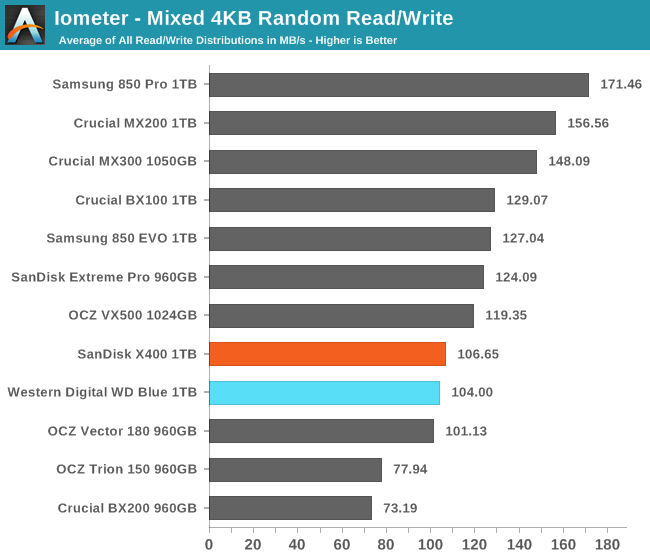
Like the SanDisk X400, the WD Blue performs better on the mixed random I/O test than competing planar TLC drives and about the same as the slowest MLC drives.

The WD Blue once again slightly raises the efficiency standards for planar TLC, but is still nowhere near as efficient as 3D TLC or MLC.
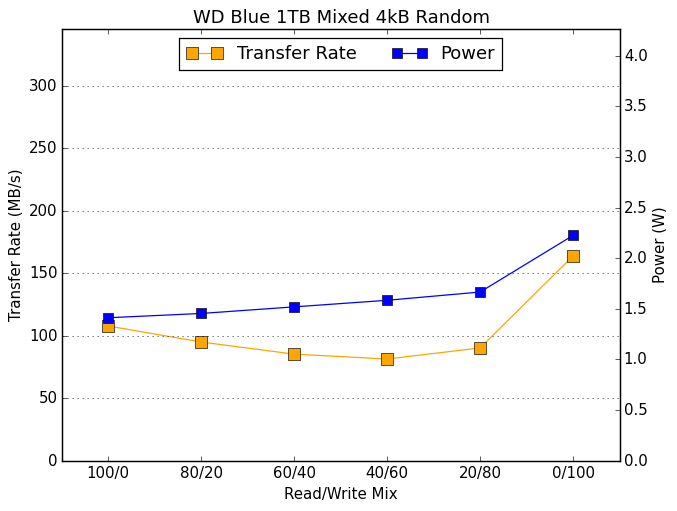 |
|||||||||
The WD Blue starts the mixed random I/O test with a pretty good random read speed, but performance declines as writes are added to the mix until near the end of the test, where the jump in the last segment of the test is not as large as what most drives experience.
Mixed Sequential Read/Write Performance
The mixed sequential access test covers the entire span of the drive and uses a queue depth of one. It starts with a pure read test and gradually increases the proportion of writes, finishing with pure writes. Each subtest lasts for 3 minutes, for a total test duration of 18 minutes. The drive is filled before the test starts.
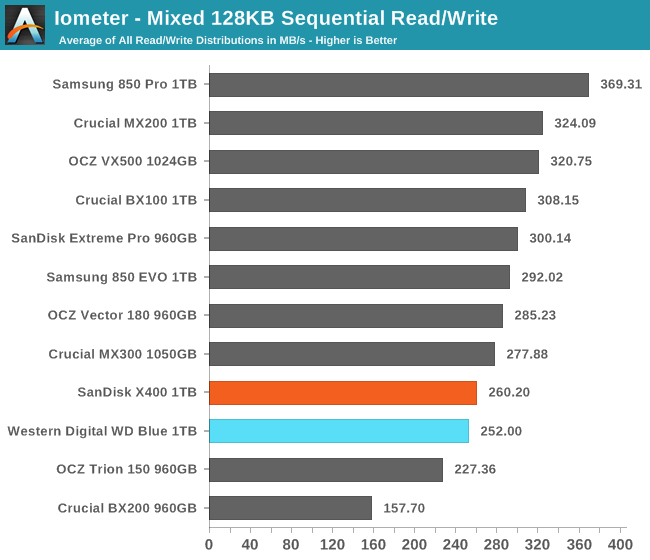
The WD Blue performs above average for a planar TLC SSD on the mixed sequential I/O test, but is not competitive with MLC or 3D TLC.
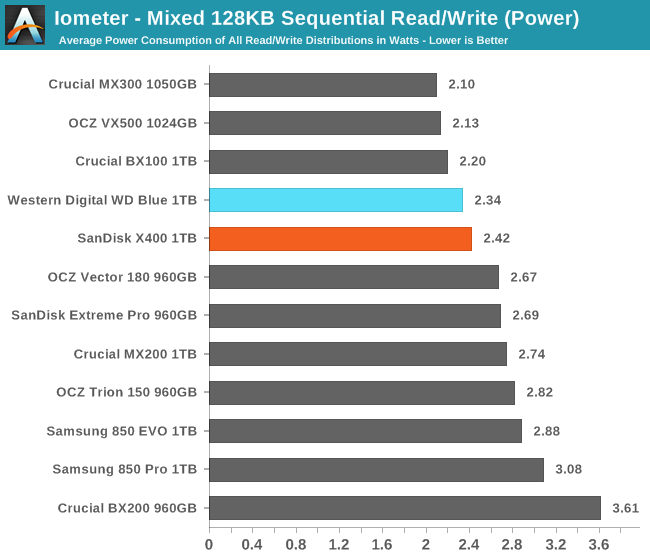
In absolute terms the WD Blue has pretty low power draw on this test, but the efficiency is not close to setting a record.
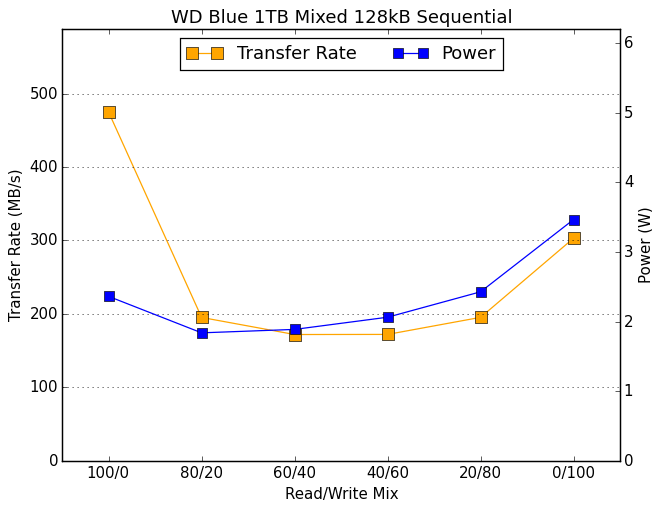 |
|||||||||
The WD Blue's U-shaped performance curve across this test is fairly typical, but the dropoff at the beginning is relatively steep and the minimum is a bit on the low side.










75 Comments
View All Comments
TheinsanegamerN - Tuesday, October 11, 2016 - link
it's an interesting drive, but why buy these when the likes of the mushkin reactor are $60 cheaper for the 1TB varient? sata III drives have peaked performance wise.OTOH, cant wait to see what the WD black SSDs look like. 4TB? M.2 PCIE?
dave_the_nerd - Tuesday, October 11, 2016 - link
The Reactor 1TB was a clone of the BX100... which outperformed the WD Blue in a lot of tests here. Getting harder to find them though.Hopefully the street price of this will be more in-line with the rest of the market, price/performance wise.
TheinsanegamerN - Tuesday, October 11, 2016 - link
the only thing this WD drive does better is write endurance. 400TB, or even 320TB for the sandisk version, is a heck of a lot better then the 144TB of the 1TB reactor drive.ammacdo - Tuesday, October 11, 2016 - link
The thing I like most about this review is seeing how well my BX100 still holds up, and I paid the same MSRP this one is going for over a year ago.paulgj - Monday, October 31, 2016 - link
I agree, I bought half a dozen BX100's when they went on sale. Excellent MLC SSDs.Bullwinkle J Moose - Tuesday, October 11, 2016 - link
It depends on the consistency of performance and not the peakThe concern I have is Sandisk consistency of performance which cannot be checked using a single test drive
I have 3 of the Sandisk Extreme Pro thumbdrives that are Windows to Go compatible as they are "Fixed Disks"
One of them is completely unusable after a week, one is so-so and one is very good (performance wise)
The only thing that will return the speed to "Like-New" condition is using Killdisk over the entire drive
The CrapCleaner Drive wipe utility does not return full performance, and the new Defraggler SSD Optimizer does not return full performance
I have not found any method other than Killdisk to temporarily regain full disk performance
Of course, not having Trim or Garbage collection exacerbates the problem which then accelerates the thermal throttling issue
Mushkin also has a bad rep for thermal issues on their Win2Go compatible thumbdrives
The new Corsair GTX beats them all hands down for Windows to go and since my test machine is an older Sandy Bridge for XP compatability, the corsair is actually faster on the USB3 port than my Samsung 850 Pro is on the SATA2 ports
I hope Anandtech can address consistency between identical drives at some point
Bullwinkle J Moose - Tuesday, October 11, 2016 - link
Corsair GTX Thumb drives seem VERY Consistent between drives as wellWwhat - Sunday, October 30, 2016 - link
You seem to be a pretty unique case and not an average user in any way.But it's still an interesting comment I feel. Or I should say 'because of that' rather than 'still'.
Bulat Ziganshin - Saturday, October 15, 2016 - link
they can't build Black from air. sandisk best ssd is extreme pro, so Black will be updated version of itnathanddrews - Tuesday, October 11, 2016 - link
Does this WD SSD come with software to clone/shrink your existing drive to the new SSD? I have an older SiliconEdge Blue 64GB SSD (still working well) and WD offers a utility on their website to do just that, but only if there is a WD drive attached to the machine. I assume this utility would work with this SSD? Not sure if you image your test drives using different tools or what.Samsung has another great utility that comes with a slick SATA-to-USB 3.0 dongle (free in the box) that will clone/shrink any drive to a target Samsung SSD. They go above and beyond the capabilities of Windows volume shrink by a lot.